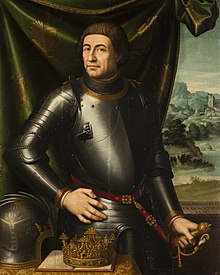Alfons V of Aragon
| Alfonso the Magnanimous | |
|---|---|

Portrait of Alfonso V of Aragon, by 16th century painter Vicente Juan Masip
|
|
| King of Aragon | |
| Reign | 2 April 1416 – 27 June 1458 |
| Predecessor | Ferdinand I |
| Successor | John II |
| King of Naples and Sicily | |
| Reign | 2 June 1442 – 27 June 1458 |
| Predecessor | René |
| Successor | Ferdinand I |
| Born | 1396 Medina del Campo, Kingdom of Castile |
| Died | 27 June 1458 (aged 61–62) Castel dell'Ovo, Naples, Kingdom of Naples |
| Burial | Poblet Monastery |
| Consort | Maria of Castile |
| Issue among others... |
Ferdinand I of Naples (illegitimate) |
| House | Trastámara |
| Father | Ferdinand I of Aragon |
| Mother | Eleanor of Alburquerque |
| Religion | Roman Catholicism |
Alfonso the Magnanimous KG (also Alphonso; Catalan: Alfons; 1396 – 27 June 1458) was the King of Aragon (as Alfonso V), Valencia (as Alfonso III), Majorca, Sardinia and Corsica (as Alfonso II), Sicily (as Alfonso I) and Count of Barcelona (as Alfonso IV) from 1416, and King of Naples (as Alfonso I) from 1442 until his death. He was one of the most prominent figures of the early Renaissance and a knight of the Order of the Dragon.
Born at Medina del Campo, he was the son of Ferdinand I of Aragon and Eleanor of Alburquerque. He represented the old line of the counts of Barcelona through the female line, and was on his father's side descended from the House of Trastamara, the reigning House of Castile. By hereditary right he was king of Sicily and claimed the island of Sardinia for himself, though it was then in the possession of Genoa. Alfonso was also in possession of much of Corsica by the 1420s.
In 1421 the childless Queen Joanna II of Naples adopted and named him as heir to the Kingdom of Naples, and Alfonso went to Naples. Here he hired the condottiero Braccio da Montone with the task of reducing the resistance of his rival claimant, Louis III of Anjou, and his forces led by Muzio Attendolo Sforza. With Pope Martin V supporting Sforza, Alfonso switched his religious allegiance to the Aragonese antipope Benedict XIII. When Sforza abandoned Louis' cause, Alfonso seemed to have all his problems solved; however, his relationship with Joanna suddenly worsened, and in May 1423 he had her lover, Gianni Caracciolo, a powerful figure in the Neapolitan court, arrested.
...
Wikipedia
